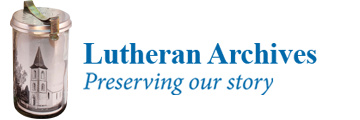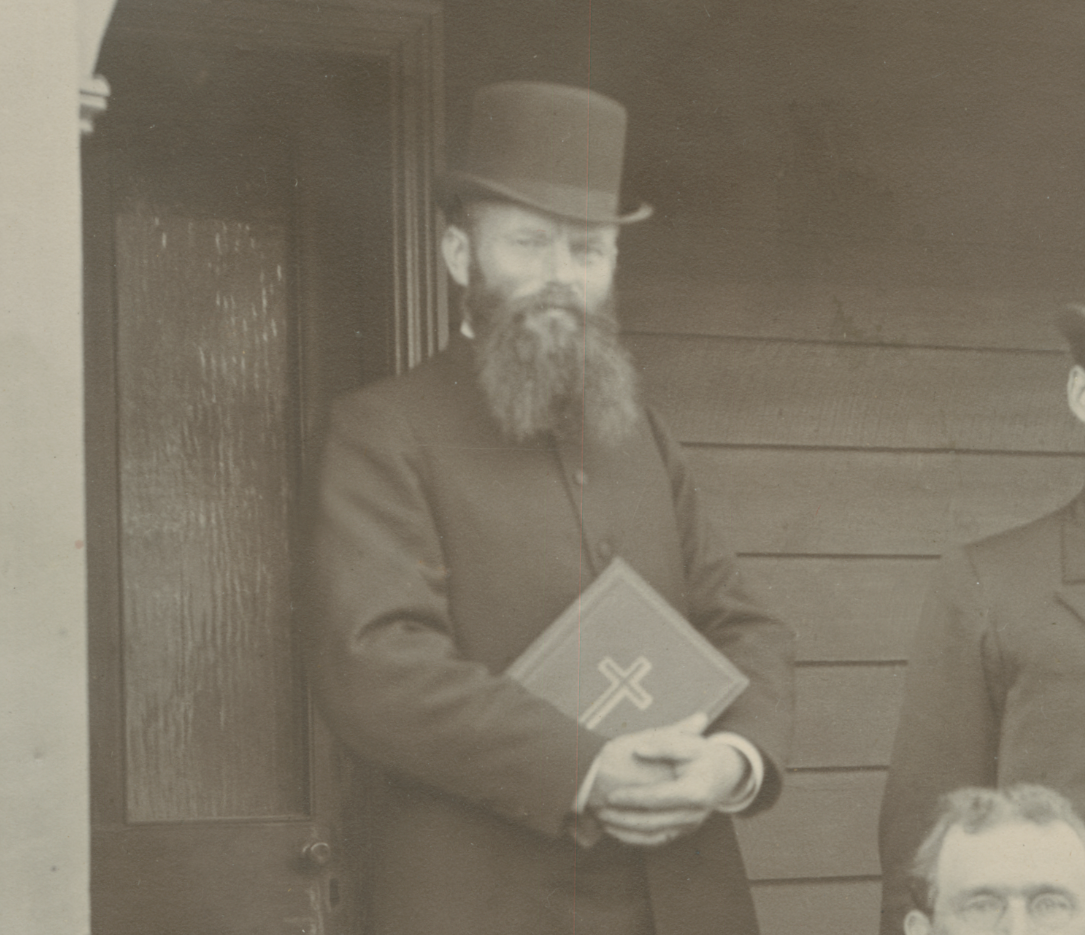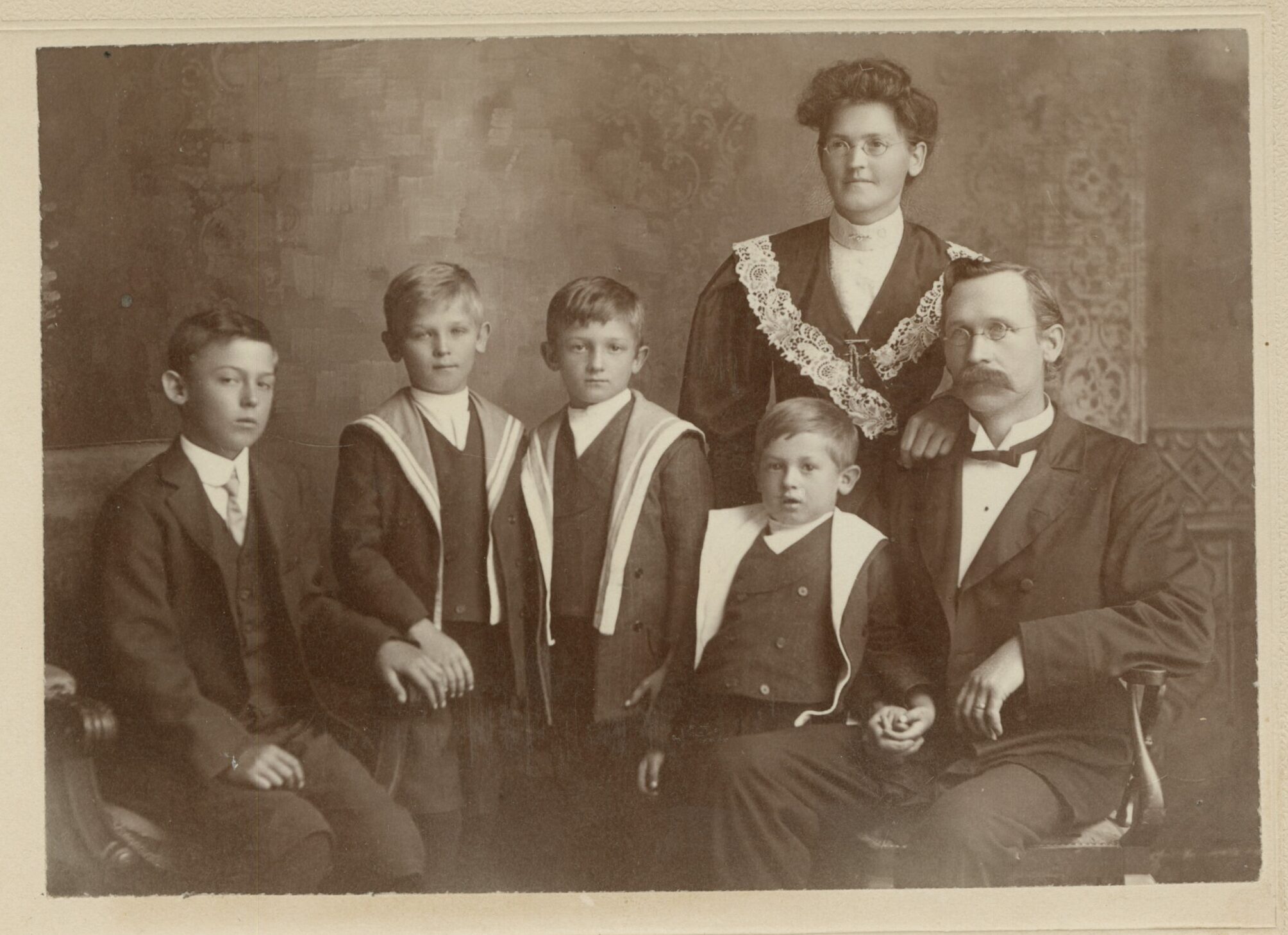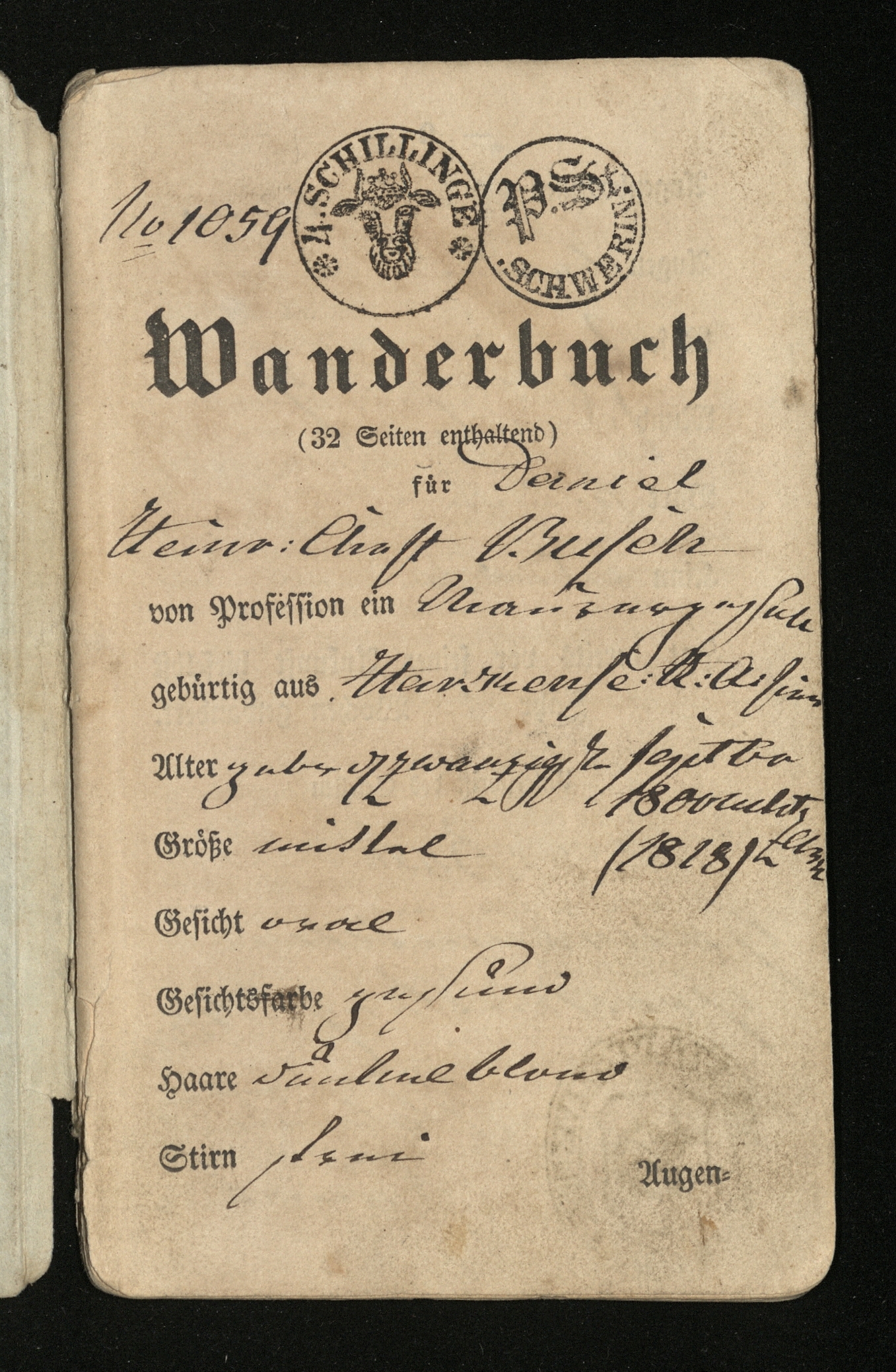Published Works and Periodicals
Lutheran Archives’ collection contains many published works and periodicals that were either produced by the Australian and New Zealand Lutheran synods or used by Lutheran communities and individuals for congregation worship, in their daily life, and in their outreach ministries.
In his first letter from South Australia to pastoral colleagues back in Prussia, Pastor Kavel urged any who might follow him to bring with them the Christian literature needed to sustain the faith and life of the church. Procuring or producing those essential resources has since then remained a constant concern of the church as reflected in the Published Works collection at Lutheran Archives.
The collection documents the practice of faith by Australian and New Zealand Lutherans – including in the vernacular (one’s ‘language of the heart’) and documents the development of worship and faith resources by LCANZ entities. The collection also illustrates the wide reading and broader interests of Lutheran families, their search for knowledge in both practical and cultural spheres, and the church’s place with the global Lutheran networks.
![Domajaza Postilla (Sorbian Sermon book) (pre 1854) [LA Sermon book Wendish]](https://lutheranarchives.lca.org.au/wp-content/uploads/2023/12/IMG_23381-scaled-e1702876228136-768x576.jpg)
![Australian Lutheran Hymnbook (1925) [LA Hymnbook 591 (2)]; Australian Lutheran Hymnbook with Tunes (1950) [LA Hymnbook 660(3)]; Lutheran Hymnal - Large Print (1979) [LA Hymnbook 604a]](https://lutheranarchives.lca.org.au/wp-content/uploads/2023/12/IMG_23271-768x576.jpg)
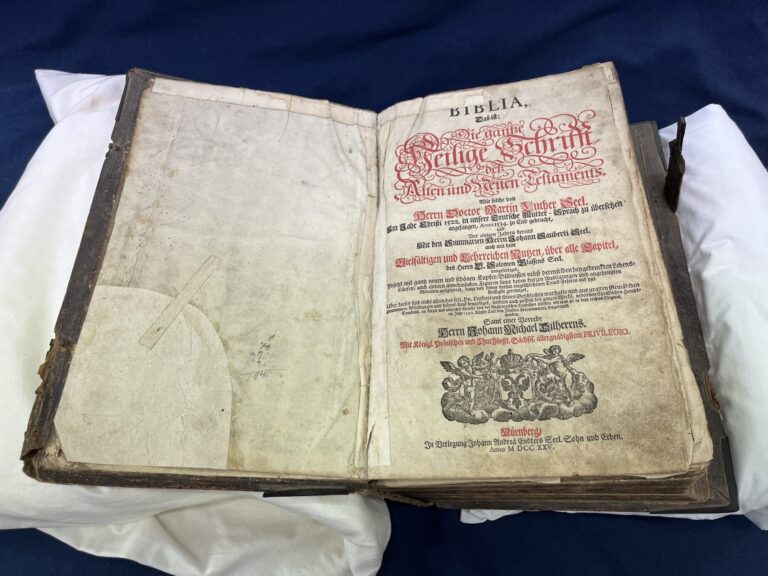
![Baptism liturgy from the Kirchen-Agende für Hof- und Domkirche in Berlin (the King Friedrich Wilhelm III 'Union' Liturgy) and a handwritten book of liturgy used in opposition to the 'Union' Liturgy [Lutheran Archives Liturgy 10D and Liturgy 13]](https://lutheranarchives.lca.org.au/wp-content/uploads/2023/12/IMG_23331-768x576.jpg)
![Testamenta Ljatinja: Aŋkatja Araṇḍauṇa Kŋaṭiwumala (Arrernte language New Testament: British and Foreign Bible Society 1987) [BF/ARA/3]](https://lutheranarchives.lca.org.au/wp-content/uploads/2023/12/IMG_23361-scaled-e1702874583350-768x576.jpg)
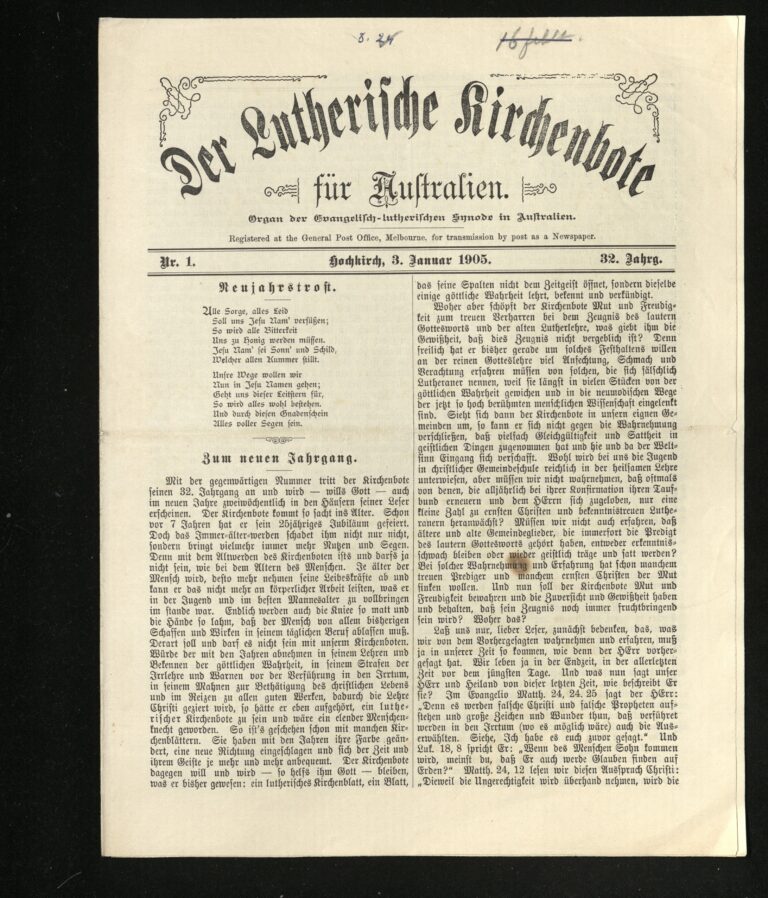
Over 800 Bibles and Bible portions are held by Lutheran Archives in over 40 languages: a central principle of practicing the Lutheran faith is that everyone should be able to read the Bible in their own language. This principle dates back to Martin Luther’s translation of the Bible into German, begun with the New Testament in 1522 and completed with the publication of the Old Testament, Apocrypha and New Testament in 1534.
As well as versions of ‘Luther’s Bible’, holdings include the ‘classical’ languages of the Bible: Greek, Hebrew, Latin; as well as Wendish/Sorbian, Estonian, Finnish, and Lithuanian editions, reflecting the country of origin of the Lutheran migrants; a range of English/American versions accompany and follow the transition to English as the dominant language of the church over time. Australian Aboriginal languages include Dieri, Pintupi/Puritja, Aranda, and, Kriol, highlighting the work of missionaries in translating the Bible/portions of the Bible into the languages of the people with whom they were ministering. This also extends to New Guinea with the Jabim, Motu, Pidgin languages represented. The first translation of the New Testament into any Australian Aboriginal language was completed in 1897 by Lutheran Missionaries Georg Reuther and Carl Strehlow at Bethesda mission, SA.
The provenance of the bible collection is primarily from two groups: Lutheran families, who initially brought their large heirloom tomes with them, or congregations, whose altar Bible was in a few instances presented by German royalty – Prince Heinrich of Prussia to St Stephens Adelaide, Empress Auguste to Temora congregation, as well as editions presented by the local youth society to their congregation.
Inclusion into the collection is based upon evidence of provenance (ownership), often determined by inscriptions or notations of family details (baptisms, marriages). The collection is not intended to be a comprehensive holding of every Bible publication or version; rather it illustrates the significance of the Bible as core to the foundation of Lutheran faith and ministry.
(Please note we are not currently accepting more family Bibles into the collection)
These works span 25 linear metres within the Archives’ collection.
Catechisms, catechetical aids and devotion books are the means of teaching and passing on the Lutheran faith, and strengthening Christians in their life of faith through regular private or family/small group devotion.
An understanding of Luther’s catechism is integral to the rite of Confirmation, which publicly affirms the sacrament of Baptism. The catechism (through question and answer form) teaches the Ten Commandments, Apostles’ Creed and Lord’s Prayer, and the sacraments of Baptism and Holy Communion. Catechism editions were closely scrutinised by the Lutheran synods and parents, particularly when supplementary material was included that varied from Luther’s Catechism.
In the German tradition, Confirmation marked the culmination of a child’s formal school and transition to adulthood – this concept was followed by the Australian and New Zealand Lutheran synods into the early 20th century. The collection features a number of exercise books containing student’s handwritten confirmation notes.
The collection contains versions predominantly in English or German, and a number are dual-language; other languages are also represented on a smaller scale. They are printed both by Australian and New Zealand Lutheran synods, or by the international synods with which they were affiliated – eg the Ohio Synod, or the Evangelical Lutheran Synodical Conference of North America. Some editions are published by individual Pastors – eg At Jesus’s Feet: Catechism Lessons by Rev RH Altus, M.A., Principal, Concordia College Toowoomba Queensland.
The devotion books are extremely varied, intended for regular use in private reflection/worship to strengthen faith, inspire Christian daily life and console in troubled times.
Clear provenance is evident in the collection through inscriptions of owners, including dedications to owners as gifts for confirmation, marriage or birthdays – gifts presented by Pastors, parents or God-parents. Whilst the early traditional German devotion books – eg Arndt, Hiller, Bogatzky, Starck – had remained in use over generations (including through translation), the development of local publishing in the 20th century has led to a focus on contemporary reflections by local authors and published by the Australian and New Zealand Lutheran synods.
The hymnal collection spans 21 linear metres.
Lutherans have a strong tradition of music to enrich worship and daily life. School teachers were required to teach hymns and music notation, play the organ (or in the early years perhaps the violin), and conduct choirs for worship services. Hymn books were customarily given as engagement or wedding gifts, with initials printed in gold on the binding. From the outset missionaries, recognising First Nations peoples’ love of singing, translated hymns into the relevant Aboriginal languages and published them in primers: this legacy can be seen in Hermannsburg Choir’s film The Songkeepers.
The great range and diversity of German hymn books in Lutheran Archives collection reflects the historical multiplicity of German state churches and their hymnals, as well as the abiding attachment of members to regional and personal hymn books – popularly known by the name of the pastor or cantor who collated and edited them (eg Freylinghausen, Burg, Porst).
As early as 1841, resolved at a synodical convention, Australian Lutherans settled on the large Breslau hymn book for standard use in congregations. It contained almost 2000 hymns – but no tunes. Some editions also contained the weekly lectionary of Gospels and Epistles, a prayer book, the Creeds, Luther’s Catechism and the Augsburg Confession.
The large Breslauer (as it is usually known) remained the standard of the two major South Australian-based Synods until it was replaced at the turn of the century by the ‘small Breslauer’ with 570 hymns printed for the ELSA in Zwickau, and an Elberfeld/ Breslau hymnal with 744 hymns imported by the Immanuel Synod.
Smaller synods or individual congregations had been importing other hymnals or producing their own hymn selections: of note is Pastor Maschmedt’s Christliches Gesangbuch for the Klemzig-Adelaide congregation.
Not all hymnals were designed for Sunday worship: special collections were produced for specific occasions, such as the large and small ‘Missionsharfe’ used for mission festivals. During the transition to English, booklets or pamplets were printed by congregations or synods for services also attended by local English Christians. The collection of English hymnals includes samples from English Protestant denominations, but many come from US Synods where the much larger Lutheran population, including Scandinavians, reached critical mass for large-scale publishing of translation and independent works much earlier than Australia.
The first Australian Lutheran hymn book in English was published in 1922 by the Lutheran Publishing Co. Ltd for the ELSA synod – this hymnal was also adopted for use by the UELCA synod.
In 1950, planning for a new joint hymnbook for both ELCA and UELCA commenced. A committee was established which met 28 times over the course of 22 years – with each session lasting for 8 days – to discuss the hymns to be included in the new hymnal. Inclusion had to meet 11 criteria, including that the hymns must be doctrinally sound, have real value for devotion and worship, be linguistically and poetically good, must measure up to the standard of good hymnody. The result of this was the publication of the LCA Hymnal in 1973 – affectionately known as the ‘black hymn book’.
Spanning 27 boxes of items over 6 linear metres.
Liturgy comprises the ‘order of service’ used in regular Sunday worship: Matins, Communion or Vespers – and includes the traditional spoken formulas for Confession and Absolution, Lord’s Prayer, Creeds, Prayer of the Church and the rites for the sacraments of Holy Communion and Baptism, together with chants or canticles inherited from the Catholic mass such as the Kyrie, Sanctus and Gloria or the Nunc Dimittis.
The liturgy is so central to Lutheran faith that the introduction and publication of a new liturgy in Prussia triggered the migration of Lutherans to Australia – Lutheran Archives holds one such copy from 1824. The liturgy was introduced by King Friedrich Wilhelm III in Prussia between 1817 and 1830: as the Reformed ruler of a predominantly Lutheran population, the King wanted to unite the two Protestant churches in his realm – initially as an administrative union. Then in a series of progressive measures he created the one ‘Evangelical Church’ with the publication of one liturgy for use in the two denominations, making its use compulsory in 1830.
Friedrich Wilhelm chose liturgical formulas for the rites of Baptism and Holy Communion which permitted a Reformed (Zwingli/ Calvin) understanding of the sacraments. After initial resistance, the new liturgy was accepted by the majority of clergy, but rejected by a number of Lutherans who became known as ‘Old Lutherans’, distancing themselves from what they called the ‘Union Church’. Clergy who refused to use this liturgy were banned from ministering and jailed if they persisted, and their ‘Old Lutheran’ adherents met in secret worship services in homes or forests, using handwritten copies of the ‘Wittenberg Agende’ that they believed their ancestors had used since the time of Luther and the Reformation.
Lutheran Archives holds one copy of the Agende produced by King Friedrich Wilhelm III and signed by him, presented to the congregation in Rakau in 1824. This work was brought to Australia in 1951 by a Post-WWII migrant Max Pachur, who became a pastor for the ELCA synod, serving a migrant congregation in Adelaide.
Lutheran Archives holds one beautifully lettered liturgy excerpt brought from Prussia, and a number of full handwritten Wittenberg liturgies neatly and carefully copied into thick exercise books by local teachers for use in fledgling congregations in SA and in the Riverina, where the worn away covers testify to sustained constant use of the hand-written books. To celebrate the 50th Jubilee of the Lutheran Church in Australia in 1888, the Immanuel Synod published the Wittenberg Agende in printed form.
Synodical liturgy books also provide formats for Confirmation, marriage, and funerals; specific prayers for each Sunday and festival of the church year, and liturgical variants for special seasons and festivals such as Lent and Easter; rites for special events in church or congregation – ordination, installation of church workers, foundation stone laying and dedication of church buildings or furnishings such as altar, font or organ. For the ELSA Liturgy Book published in German in 1888 (translated to English, 1913) the text with musical settings amounted to 335 pages.
Other liturgies and liturgical materials in the collection come from German state churches and American Synods, and English liturgies produced in Australia and New Zealand by the various synods.
The collection covers 17 linear metres.
The oldest book in the Lutheran Archives collection is a volume dated 1553 from the first edition of Luther’s collected works (the Wittenberg edition). It was brought to Australia in 1847 by Pastor Philipp Jacob Oster, who was coming to South Australia to establish a seminary for pastors and teachers – but unfortunately died during the voyage enroute. Pastor Oster held 4 volumes which contain Luther’s writings on Genesis and the Prophets; on the Epistles; and 2 volumes of assorted writings.
The most comprehensively held edition at Lutheran Archives is the Complete Works edited in 24 volumes by Johann Georg Walch 1739-50 and published in Halle: 10 volumes present Luther’s University lectures on the books of the Bible with associated sermons; the Church and House Postillen (sermon books); Reformation writings and disputes; thematically arranged pamphlets and associated texts; Correspondence; and Table Talk.
The ownership of the two almost complete sets (Walch edition) demonstrates that laymen as well as theologians engaged with the foundational texts of Lutheran teaching: a number of these volumes were brought to South Australia by Teacher Friedrich Topp of Bethany. Farmer Theo Heinrich received his copies “by the grace of God” in 1863, at the time when South Australia was debating compulsory education: Heinrich emphatically marked the margins of passages when Luther advocated punishment for parents who refused to send their children to school. This edition was revised and reprinted in St Louis 1880-1910 and used in the library of Concordia Seminary Adelaide.
Other collected or selected editions include volumes of the Erlangen edition (1826-67) from the Trinity Church in Melbourne and an 8-volume set owned by Clamor Schürmann.
The Luther collection also encompasses smaller selections from Luther’s writings including devotional “Treasure Chests”; Luther biographies; guides to Luther sites in Germany; and programs for Luther anniversaries in Germany, the US and Australia.
Australia and New Zealand
From the 1860s Australian synods published periodicals to communicate news and to support congregations and members in their daily life as Lutherans.
Content included: devotional, doctrinal and didactic articles, as well as news from their own synod and other Lutheran synods – with detailed obituaries, mission reports, and reports on special events such as dedications, installations, mission festivals and synodical conventions. Issues also included news from Lutherans and other denominations and religions around the world, together with a Christian perspective on social and political issues in the Australian colonies and elsewhere. Supplements included personal notices, especially death notices; serialised historical and religious fiction; and commercial advertising.
They were published in German until the end of 1917. However, already before WWI, the ELCA synod published the Australian Lutheran in English, and the German church papers were in general superseded by English-language magazines.
From the 1940s, special pages previously devoted to developing specific ministries or auxiliaries such as Luther League, Womens Guild or Sunday School / children were gradually replaced by independent magazines featuring devotional and Bible study materials as well as personal interest stories, extensive reports on conventions or rallies, and news from individual districts or societies.
Examples include:
- year books/almanacs
- synod newspapers including Australian Lutheran and Der lutherische Kirchenbote [ELCA], Lutheran Herald [UELCA], Kirchen und Missions Zeitung [Immanuel Synod], The Lutheran [LCA/LCANZ], New Zealand Lutheran (LCNZ)
- district newsletters
- newsletters produced by departments, ministries or auxiliaries eg Lutheran Women
- annual college and seminary magazines
International
Australian and New Zealand synods had close international Lutheran affiliations and contacts, primarily with German and American Lutheran synods, mission societies, seminaries and church communities.
These periodicals document the international contexts and influences in Australian and New Zealand theological debates, mission work, church practice and congregational life.
Few examples remain of the earliest mission periodicals sparingly supplied to the Dresden and Gossner missionaries, but such journals became the staple source for the monthly Monday evening ‘Mission Hours’ held in many congregations. The editors of Australian church papers, who were at the same time parish pastors, often re-printed articles from foreign Lutheran papers to substantiate their stance in doctrinal debates, raise concerns regarding church life and promote interest in mission work around the world.
Examples of holdings include:
Mission Society periodicals – extensive sets from Neuendettelsau, Basel, Hermannsburg, Jewish mission
Lutheran Church Missouri Synod (LCMS): 1) Lutheran Witness periodical, 1913ff; 2) LCMS synod reports
- Ohio Synod USA: 1) The Pastors Monthly, 1923-1935 2) Yearbooks
- Walther League USA: The Bible Student, 1922-1943
- Die Abendschule, 1890s
- Lutheran World Federation (LWF): 1) Lutheran World, 1954ff; 2) Annual reports
The collections of Published Works contain many books printed before 1800 – considered rare because they pre-date the technical advances in the 19th century that enabled simpler print runs and cheaper books.
Since large-scale German/Lutheran migration to Australia began in 1837, works printed prior to 1840-50 can in general be seen as pertaining to the immigrants’ life in the homeland: treasured possessions brought with them to their new home. Many of the older books however were sent to Australia by the Berlin bookseller Wohlgemuth as second-hand books for sale by his agent to the early settlers.
The pre-1800 books, ranging from Hebrew dictionaries to devotional works can be located within their respective subject collections such as Bibles, Luther’s Works, Hymnbooks or the secular collections.
The earliest work dates back to 1554 and is an edition of Luther’s Works brought to Australia by Pastor Oster Senior.
A contemporary collection that gives contextual understanding to the LCANZ and preceding synods, including establishment, activities and ministries, and worship life.
Subjects include, but are not limited to: background history of the German lands, Prussia, Poland; migration, settlement, nomenclature, local histories; WWI and WWII anti-German sentiment; music and religion; Australian Aboriginal history, language, anthropology, art; Moravian missions and settlements; shipping histories; education and schooling; German and Wendish customs and festivals; religious art.
As with all our collection, items within this collection are not available for loan. Works can only be accessed in our reading room.
This collection of books in German dates predominantly to the 1800s, and highlights the wide reading and cultural interests of early Lutherans in Australia and New Zealand, and documents their continuing attachment to that culture while at the same time reflecting the types of practical knowledge they sought in establishing a new life in their adopted homeland.
Topics covered in this collection include:
- German literature, poetry (eg Schiller and Goethe)
- The Mecklenburg Plattdeutsch works of Fritz Reuter
- Biographies and autobiography of churchmen, missionaries, writers and artists
- Regional and national history
- Religious and regional fiction
- Geography and travel
- Technical and science books
- Medical (including animal husbandry), Homeopathy
- Education: including primers, readers, text-books, pedagogy, subject materials including both secular and religious.
- Children’s and youth literature, including an extensive collection from the Light Pass Congregation library
Please note that we are not accepting further deposits into this collection.
The collection, spanning 30 linear metres, demonstrates extensive useage in Prussia prior to migration, and Australia and New Zealand, and used both by pastors, and within congregations and families.
Lutheran sermon books, beginning with Luther’s Postillen, were used by the Prussian ‘Old Lutherans’ in their banned and secret devotions and, following migration, were then used by congregations and families in Australia and New Zealand.
A copy of the “Domjaza Postilla”, Luther’s Hauspostille translated into Wendish (published in Bautzen in 1844) is inscribed “Johann Petzold in Nechern 1845”. It was brought to South Australia by his daughter Magdalena and her husband Peter Zwar in 1854, when they settled in EbenEzer.
But small congregations in Silesian mountain villages, and the new scattered German settlements in Posen also relied on sermons read by the local teacher on the many Sundays when the parish pastor was unable to visit: Lutheran Archives holds 8 copies of the most popular of their sermon books, Gottfried Kleiner’s Prediger und Hirten Stimme (The Voice of the Preacher and Shepherd): our oldest copy – 1000 pages thick and bound with clasps – was published in 1730, the latest in 1874, the 35th reprint in the 19th century.
In Australia too, the Lutheran tradition of lay-reading rather than lay-preaching has meant that in widespread parishes – some visited by a pastor only 4 times a year – a lay-reading service was the most common form of worship, at least until the advent of the motor car. American and Australian synods published sermon collections in German or English specifically for their parishes, and the collected assortment of of highly varied single-sermon pamphlets also includes, for example, three extensive 20th century series of ‘Light for the Way’ sermons written by ELCA pastors.
The standard sermon book (as were published by eminent theologians over the centuries) provided a sermon for each Sunday and festival day of the church year, and followed the traditional lectionary of set Gospel and/or Epistle texts.
Smaller collections of sermons were devoted to particular seasons such as Lent, or occasions such as confirmation, marriage or burial – including a set by Emil Ohly for the all-too-common burial of infants, entitled Dein Kind lebt! (Your child lives!). Such ‘Occasional Sermon’ collections also covered significant church events such as ordinations and installations and the dedication of a church, school, organ or cemetery. Later American instances also covered conferences, gatherings of women’s societies and evangelism campaigns.
Sermon books previously owned by individual pastors reflect their pastoral studies and the international seminaries that the Australian and New Zealand synods were affiliated with: many of the works are volumes by Louis Harms (Hermannsburg), Wilhelm Löhe (Neuendettelsau) or CF Walther (Missouri seminaries). Also evident however, is the ‘branching out’ from these foundational texts – the collection also encompasses a broad range of authors used by pastors in refining and expanding their preaching skills while in office.
Ownership and usage by laity/families in their daily religious life is also evident: volumes of Christian Scriver’s Seelen Schatz, The Soul’s Treasure, (first published in 1675) were owned by several pastors – but one volume belonged to Silesian wheelwright Carl Wilhelm Klingner and his wife Annna Elisabeth at Stockwell SA, who recorded the births of their 10 children in the book. Gottfried Schatter’s book of Gospel sermons published in 1794 is inscribed as a gift from the village teacher to the Gröschke family on their emigration from Heinersbrück near Cottbus to Australia in 1858.
Covering 21 linear metres.
The theology collection has grown predominantly from deposits from Pastors’ estates: reflecting the resources used in their training and in further study throughout their ministry.
The holdings encompass all branches of theology – symbolics, dogmatics, homiletics, pastoral theology – and include a strong focus on commentaries on the books of the Bible.
The collection is largely in German – including the more recent American works; the collection covers several centuries of works; and it also reflects the emphases of the seminaries where the pastors were trained (Harms, Löhe, Pieper, Reu). It includes a number of hand-copied course texts like the Christlicher Glaubenslehre auf lutherischer Grundlage für die Schüler der Missionsanstalt Neuendettelsau (Teachings of the Christian faith on a Lutheran basis for the students of the Meiendettelsau Mission Institute: drafted by Inspektor F Bauer, expanded by Inspektor Joh. Deinzer and Martin Deinzer, and neatly written out by Australian Pastor Lou Döhler during his pastoral studies at Neuendettelsau Seminary in 1909-12.
A copy of Der Glaube der Christenheit (The Faith of Christianity) by the prominent theology professor Helmut Thielicke (1908-86) is inscribed “In Verbundenheit des Glaubens (In the bond of faith) Thielicke“, and is possibly a memento of Thielicke’s visit to Adelaide in March 1979 for the 25th anniversary of the Adelaide University Lutheran Students Fellowship, as part of a lecture tour to Australia and New Zealand.
Sample some stories
Gottlieb Blaess – Missionary to the Māori
When 29-year-old theological student Gottlieb Blaess returned from his Christmas holidays in the winter of 1893, he found a letter waiting for him: a call from the Hermannsburg Free Church to serve as missionary in New Zealand.
Emma Kriewaldt – Diary of a Pastor’s Wife
At the age of 23, Emma Kriewaldt nee Eberlein moved from Shawano, Wisconsin, USA to Lobethal in South Australia with her husband Emil Kriewaldt, an LCMS pastor who had been called to serve in Australia.
Two German tradesmen and their Wanderbücher
These Wanderbücher document the journeyman travels of two German tradesmen: stone mason Daniel Heinrich Christian Busch and carpenter Friedrich Johann Christian Juers.
